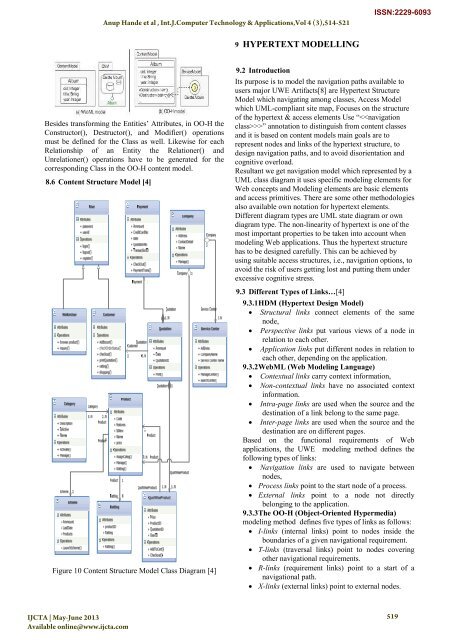Survey of Existing Web Models Techniques to Design Web Application
Survey of Existing Web Models Techniques to Design Web Application
Survey of Existing Web Models Techniques to Design Web Application
Create successful ePaper yourself
Turn your PDF publications into a flip-book with our unique Google optimized e-Paper software.
Anup Hande et al , Int.J.Computer Technology & <strong>Application</strong>s,Vol 4 (3),514-521<br />
ISSN:2229-6093<br />
9 HYPERTEXT MODELLING<br />
Besides transforming the Entities’ Attributes, in OO-H the<br />
Construc<strong>to</strong>r(), Destruc<strong>to</strong>r(), and Modifier() operations<br />
must be defined for the Class as well. Likewise for each<br />
Relationship <strong>of</strong> an Entity the Relationer() and<br />
Unrelationer() operations have <strong>to</strong> be generated for the<br />
corresponding Class in the OO-H content model.<br />
8.6 Content Structure Model [4]<br />
Figure 10 Content Structure Model Class Diagram [4]<br />
9.2 Introduction<br />
Its purpose is <strong>to</strong> model the navigation paths available <strong>to</strong><br />
users major UWE Artifacts[8] are Hypertext Structure<br />
Model which navigating among classes, Access Model<br />
which UML-compliant site map, Focuses on the structure<br />
<strong>of</strong> the hypertext & access elements Use “>” annotation <strong>to</strong> distinguish from content classes<br />
and it is based on content models main goals are <strong>to</strong><br />
represent nodes and links <strong>of</strong> the hypertext structure, <strong>to</strong><br />
design navigation paths, and <strong>to</strong> avoid disorientation and<br />
cognitive overload.<br />
Resultant we get navigation model which represented by a<br />
UML class diagram it uses specific modeling elements for<br />
<strong>Web</strong> concepts and Modeling elements are basic elements<br />
and access primitives. There are some other methodologies<br />
also available own notation for hypertext elements.<br />
Different diagram types are UML state diagram or own<br />
diagram type. The non-linearity <strong>of</strong> hypertext is one <strong>of</strong> the<br />
most important properties <strong>to</strong> be taken in<strong>to</strong> account when<br />
modeling <strong>Web</strong> applications. Thus the hypertext structure<br />
has <strong>to</strong> be designed carefully. This can be achieved by<br />
using suitable access structures, i.e., navigation options, <strong>to</strong><br />
avoid the risk <strong>of</strong> users getting lost and putting them under<br />
excessive cognitive stress.<br />
9.3 Different Types <strong>of</strong> Links…[4]<br />
9.3.1 HDM (Hypertext <strong>Design</strong> Model)<br />
• Structural links connect elements <strong>of</strong> the same<br />
node,<br />
• Perspective links put various views <strong>of</strong> a node in<br />
relation <strong>to</strong> each other.<br />
• <strong>Application</strong> links put different nodes in relation <strong>to</strong><br />
each other, depending on the application.<br />
9.3.2 <strong>Web</strong>ML (<strong>Web</strong> Modeling Language)<br />
• Contextual links carry context information,<br />
• Non-contextual links have no associated context<br />
information.<br />
• Intra-page links are used when the source and the<br />
destination <strong>of</strong> a link belong <strong>to</strong> the same page.<br />
• Inter-page links are used when the source and the<br />
destination are on different pages.<br />
Based on the functional requirements <strong>of</strong> <strong>Web</strong><br />
applications, the UWE modeling method defines the<br />
following types <strong>of</strong> links:<br />
• Navigation links are used <strong>to</strong> navigate between<br />
nodes,<br />
• Process links point <strong>to</strong> the start node <strong>of</strong> a process.<br />
• External links point <strong>to</strong> a node not directly<br />
belonging <strong>to</strong> the application.<br />
9.3.3 The OO-H (Object-Oriented Hypermedia)<br />
modeling method defines five types <strong>of</strong> links as follows:<br />
• I-links (internal links) point <strong>to</strong> nodes inside the<br />
boundaries <strong>of</strong> a given navigational requirement.<br />
• T-links (traversal links) point <strong>to</strong> nodes covering<br />
other navigational requirements.<br />
• R-links (requirement links) point <strong>to</strong> a start <strong>of</strong> a<br />
navigational path.<br />
• X-links (external links) point <strong>to</strong> external nodes.<br />
IJCTA | May-June 2013<br />
Available online@www.ijcta.com<br />
519
















